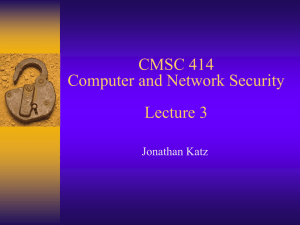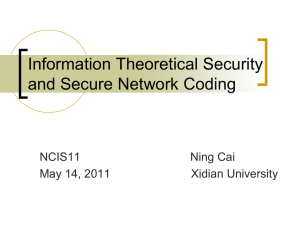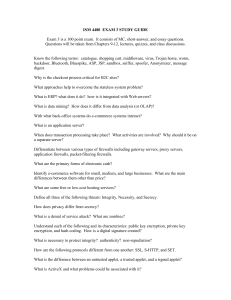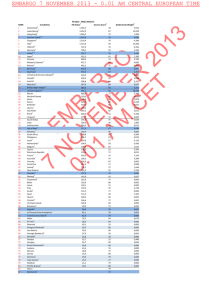On Secure Network Coding with Unequal Link J ¨org Kliewer
advertisement
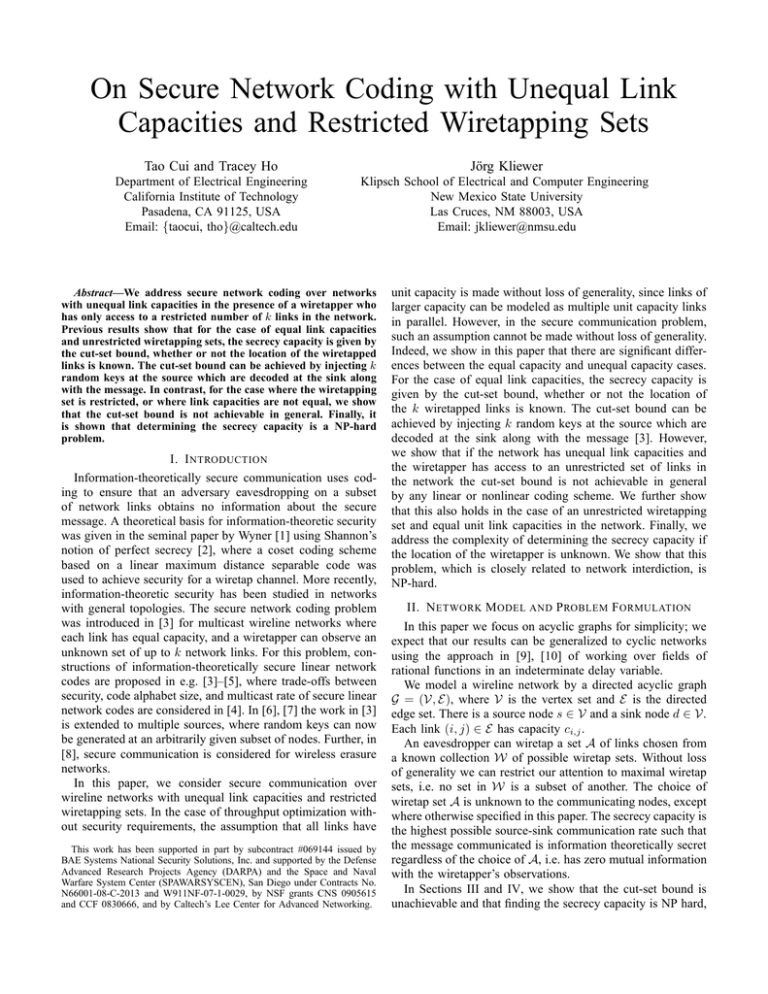
On Secure Network Coding with Unequal Link
Capacities and Restricted Wiretapping Sets
Tao Cui and Tracey Ho
Jörg Kliewer
Department of Electrical Engineering
California Institute of Technology
Pasadena, CA 91125, USA
Email: {taocui, tho}@caltech.edu
Klipsch School of Electrical and Computer Engineering
New Mexico State University
Las Cruces, NM 88003, USA
Email: jkliewer@nmsu.edu
Abstract—We address secure network coding over networks
with unequal link capacities in the presence of a wiretapper who
has only access to a restricted number of k links in the network.
Previous results show that for the case of equal link capacities
and unrestricted wiretapping sets, the secrecy capacity is given by
the cut-set bound, whether or not the location of the wiretapped
links is known. The cut-set bound can be achieved by injecting k
random keys at the source which are decoded at the sink along
with the message. In contrast, for the case where the wiretapping
set is restricted, or where link capacities are not equal, we show
that the cut-set bound is not achievable in general. Finally, it
is shown that determining the secrecy capacity is a NP-hard
problem.
I. I NTRODUCTION
Information-theoretically secure communication uses coding to ensure that an adversary eavesdropping on a subset
of network links obtains no information about the secure
message. A theoretical basis for information-theoretic security
was given in the seminal paper by Wyner [1] using Shannon’s
notion of perfect secrecy [2], where a coset coding scheme
based on a linear maximum distance separable code was
used to achieve security for a wiretap channel. More recently,
information-theoretic security has been studied in networks
with general topologies. The secure network coding problem
was introduced in [3] for multicast wireline networks where
each link has equal capacity, and a wiretapper can observe an
unknown set of up to k network links. For this problem, constructions of information-theoretically secure linear network
codes are proposed in e.g. [3]–[5], where trade-offs between
security, code alphabet size, and multicast rate of secure linear
network codes are considered in [4]. In [6], [7] the work in [3]
is extended to multiple sources, where random keys can now
be generated at an arbitrarily given subset of nodes. Further, in
[8], secure communication is considered for wireless erasure
networks.
In this paper, we consider secure communication over
wireline networks with unequal link capacities and restricted
wiretapping sets. In the case of throughput optimization without security requirements, the assumption that all links have
This work has been supported in part by subcontract #069144 issued by
BAE Systems National Security Solutions, Inc. and supported by the Defense
Advanced Research Projects Agency (DARPA) and the Space and Naval
Warfare System Center (SPAWARSYSCEN), San Diego under Contracts No.
N66001-08-C-2013 and W911NF-07-1-0029, by NSF grants CNS 0905615
and CCF 0830666, and by Caltech’s Lee Center for Advanced Networking.
unit capacity is made without loss of generality, since links of
larger capacity can be modeled as multiple unit capacity links
in parallel. However, in the secure communication problem,
such an assumption cannot be made without loss of generality.
Indeed, we show in this paper that there are significant differences between the equal capacity and unequal capacity cases.
For the case of equal link capacities, the secrecy capacity is
given by the cut-set bound, whether or not the location of
the k wiretapped links is known. The cut-set bound can be
achieved by injecting k random keys at the source which are
decoded at the sink along with the message [3]. However,
we show that if the network has unequal link capacities and
the wiretapper has access to an unrestricted set of links in
the network the cut-set bound is not achievable in general
by any linear or nonlinear coding scheme. We further show
that this also holds in the case of an unrestricted wiretapping
set and equal unit link capacities in the network. Finally, we
address the complexity of determining the secrecy capacity if
the location of the wiretapper is unknown. We show that this
problem, which is closely related to network interdiction, is
NP-hard.
II. N ETWORK M ODEL AND P ROBLEM F ORMULATION
In this paper we focus on acyclic graphs for simplicity; we
expect that our results can be generalized to cyclic networks
using the approach in [9], [10] of working over fields of
rational functions in an indeterminate delay variable.
We model a wireline network by a directed acyclic graph
G = (V, E), where V is the vertex set and E is the directed
edge set. There is a source node s ∈ V and a sink node d ∈ V.
Each link (i, j) ∈ E has capacity ci,j .
An eavesdropper can wiretap a set A of links chosen from
a known collection W of possible wiretap sets. Without loss
of generality we can restrict our attention to maximal wiretap
sets, i.e. no set in W is a subset of another. The choice of
wiretap set A is unknown to the communicating nodes, except
where otherwise specified in this paper. The secrecy capacity is
the highest possible source-sink communication rate such that
the message communicated is information theoretically secret
regardless of the choice of A, i.e. has zero mutual information
with the wiretapper’s observations.
In Sections III and IV, we show that the cut-set bound is
unachievable and that finding the secrecy capacity is NP hard,
even for the following special cases:
1) Scenario 1 is a wireline network with equal link capacities, where the wiretapper can wiretap an unknown
subset of k links from a known collection of vulnerable
network links.
2) Scenario 2 is a wireline network with unequal link capacities, where the wiretapper can wiretap an unknown
subset of k links from the entire network.
It is convenient to show these results for Scenario 1 first, and
then show the corresponding results for Scenario 2, by converting the Scenario 1 networks considered into corresponding
Scenario 2 networks for which the same result holds.
III. U NACHIEVABILITY
OF CUT- SET
Let S denote the set complement of a set S. A cut for
x, y ∈ V is a partition of V into two sets Vx and Vxc such that
x ∈ Vx and y ∈ Vxc . For the x − y cut given by Vx , the cut-set
[Vx , Vxc ] is the set of edges going from Vx to Vxc , i.e.,
[Vx , Vxc ] = {(u, v)|(u, v) ∈ E, u ∈ Vx , v ∈ Vxc } .
Theorem 1. Consider a network of point-to-point links, where
link (i, j) has capacity ci,j . The secrecy capacity Rs is upper
bounded by
X
ci,j .
(2)
min
min
(i,j)∈[Vs ,Vsc ]∩Ac
This upper bound applies whether or not the communicating
nodes have knowledge of the chosen wiretap set A.
Proof: Consider any source-sink cut Vs and any wiretap
set A ∈ W. Denote by X the transmitted signals from nodes in
Vs over links in [Vs , Vsc ] and denote by Y and Z the observed
signals from links in [Vs , Vsc ] and in [Vs , Vsc ] ∩ A, respectively.
We consider block coding with block length n. By the perfect
secrecy requirement H(M |Zn ) = H(M ) we have
nRs ≤H(M |Zn )
(a)
≤ H(M |Zn ) − H(M |Yn ) + nǫn
=H(M |Zn ) − H(M |Yn , Zn ) + nǫn
=I(M ; Yn |Zn ) + nǫn
n
n
≤ I(X ; Y |Z ) + nǫn
n
n
X
(c) X
≤
H(Yi |Zi ) −
H(Yi |Xi , Zi ) + nǫn ,
i=1
=nI(X; Y|Z) + nǫn ,
=n (H(X|Z) − H(X|Z, Y)) + nǫn ,
=n (H(X|Z) − H(X|Y)) + nǫn ,
≤n max (I(X; Y) − I(X; Z)) + nǫn
p(X)
X
=n
ci,j + nǫn ,
(i,j)∈[Vs ,Vsc ]∩Ac
e
6
s
b
3
f
7
8
c
4
g
5
Fig. 1. An example to show that the secrecy rate without knowledge of
wiretapping set is smaller than that with such knowledge. The wiretapper can
wiretap any three of the five links in the middle layer.
where ǫn → 0 as n → +∞ and
(a) is due to Fano’s inequality;
(b) is due to the data processing inequality and the
fact that M → Xn → Yn → Zn forms a Markov
chain;
(c) is due to the definition of the mutual information.
Note that Theorem 1 is a generalization of the bound in [6]
to arbitrary link capacities.
If the choice of wiretap set A is known to the communicating nodes, the cut-set bound (2) is achievable using a network
code that does not send any flow on links in A. In the case
of unrestricted wiretapping sets and unit link capacities, the
secrecy capacity is equal to the cut-set bound [3]. In contrast,
we now show that the cut-set bound is not achievable in
general when the wiretap set A is unknown, by considering
the example in Fig. 1, where the set of wiretappable links
is restricted (Scenario 1). We use the program Information
Theoretic Inequalities Prover (Xitip) [11] to show that the
secrecy capacity is bounded away from the cut-set bound. We
then convert the example into one with unequal link capacities
(Scenario 2), and show the unachievability of the cut-set bound
for this case also.
A. Restricted Wiretap Set (Scenario 1)
n
i=1
2
(1)
We can state the following cut-set upper bound which
applies to the general model of Section II including both
scenarios 1 and 2:
(b)
a
B OUND
c
{Vs : Vs is an s−d cut} A∈W
1
(3)
In Fig. 1, let the middle layer links be 1-5 (from top to
bottom) and the last layer links be 6-8 (from top to bottom).
All links have unit capacity. Let the signal carried by link i be
called signal i, or Si . Let the source information be denoted
X. For this example, the secrecy rate is two if any three of
the five links in the middle layer are deleted, i.e., the number
of wiretapped links is three.
The constraints required are that the source information
is a function of the signals on the sink’s incoming links,
and that there is zero mutual information between the source
information and the signals on the links in each adversarial
subset.
d
In this example, the cut-set bound is 2. To provide intuition,
we first show that secrecy rate 2 cannot be achieved by
using linear coding. This argument can be converted to an
information theoretic proof that secrecy rate 2 cannot be
achieved using any coding schemes [12].
Suppose secrecy rate 2 is achievable with a linear network
code. First note that the source cannot inject more than unit
amount of random key, otherwise the first layer cannot carry
two units of source data. Let the random key injected by the
source be denoted K. For the case when the source injects
a unit amount of secret key, we first have the following
observations. Signal 6 must be a function of signal 1, otherwise
if the adversary sees the signals 2-4 then he knows signals 67. Also, signal 8 must be a function of signal 5, otherwise if
the adversary sees signals 1, 2 and 4, then he knows signals
7-8. Similarly we can show that signal 8 must be a function
of signal 1, and signal 7 must be a function of signal 2. We
consider the following two cases.
Case 1: signal 5 is a linear combination of signals present at
the source node. To achieve the full key rank condition on links
1, 2 and 5, the top second layer node (a) must put independent
local keys k1 and k2 on links 1 and 2 respectively. Link 7,
whose other input is independent of k2 , is then a function of
k2 . Similarly, Link 8 is a function of k1 . This means that the
last layer has two independent local keys on it.
Case 2: signal 5 is a linear combination of signals present
at the source node as well as a local key k injected by the
bottom second layer node (c).
Case 2a: k is also present in signal 1. Then k is present in
signal 6, and is independent of the key present in signal 7.
Case 2b: k is not present in signal 1. Then k is present in
signal 8, and is independent of the key present in signal 7.
From Cases 1, 2a, and 2b, we conclude that the secrecy rate
without knowledge of the wiretapping set by using only linear
network coding is less than two.
We can also show that the secrecy rate is bounded away
from 2 by using the framework for linear information inequalities [13]. Let X be the message sent from the source and Zi ,
i = 1, . . . , 3 be the signals on the links adjacent to the source.
We want to check whether H(X) ≤ ω is implied by
(1)
(2)
(3)
(4)
(5)
(6)
(7)
(8)
(9)
(10)
(11)
(12)
(13)
H(Zi ) ≤ 1, H(Sj ) ≤ 1, i = 1, . . . , 3, j = 1, . . . , 8,
H(X|S6 , S7 , S8 ) = 0,
I(X, Z1 , Z2 , Z3 , S4 , S5 , S7 , S8 ; S6 |S1 , S2 , S3 ) = 0,
I(X, Z1 , Z2 , Z3 , S1 , S3 , S5 , S6 , S8 ; S7 |S2 , S4 ) = 0,
I(X, Z1 , Z2 , Z3 , S2 , S3 , S6 , S7 ; S8 |S1 , S4 , S5 ) = 0,
I(X; S1 , S2 , S3 ) = 0, I(X; S1 , S2 , S4 ) = 0,
I(X; S1 , S2 , S5 ) = 0, I(X; S1 , S3 , S4 ) = 0,
I(X; S1 , S3 , S5 ) = 0, I(X; S1 , S4 , S5 ) = 0,
I(X; S2 , S3 , S4 ) = 0, I(X; S2 , S3 , S5 ) = 0,
I(X; S2 , S4 , S5 ) = 0, I(X; S3 , S4 , S5 ) = 0,
I(S1 ; Z2 |Z1 , Z3 ) = 0, I(S2 ; Z2 , Z3 |Z1 ) = 0,
I(S3 ; Z3 |Z1 , Z2 ) = 0, I(S4 ; Z1 , Z3 |Z2 ) = 0,
I(S5 ; Z1 , Z2 |Z3 ) = 0, I(S1 ; S4 |Z1 , Z2 , Z3 ) = 0,
(14) I(S2 ; S4 , S5 |Z1 , Z2 , Z3 ) = 0,
I(S3 ; S5 |Z1 , Z2 , Z3 ) = 0,
(15) I(S4 ; S1 , S2 , S5 |Z1 , Z2 , Z3 ) = 0,
I(S5 ; S2 , S3 , S4 |Z1 , Z2 , Z3 ) = 0,
(16) I(S1 , S2 , S3 , S4 , S5 ; X|Z1 , Z2 , Z3 ) = 0,
(4)
where the first inequality is the capacity constraint, the second
constraint shows that the sink can decode X, constraints (3)
to (5) mean that the signals in the last layer are independent
of other signals given the incoming signals from the middle
layer, constraints (6) to (10) represent the secrecy constraints
when any three links in the middle layer are wiretapped, and
constraints (11) to (16) represent the conditional independence
between the signals in the first layer and those in the middle
layer. In particular, (16) shows that X → (Z1 , Z2 , Z3 ) →
(S1 , . . . , S5 ) forms a Markov chain. Note that constraints (3)
to (5) and (11) to (16) implicitly allow some randomness to be
injected at the corresponding nodes. We use the Xitip program
[11], which relies on the framework in [13], to show that
H(X) ≤ 5/3 is implied by the set of equalities (4). Therefore,
5/3 is an upper bound on the secrecy rate when the location
of wiretapper is unknown, which is less than the secrecy rate
2 achievable when such information is known.
B. Unequal Link Capacities (Scenario 2)
We next show that the unachievability of the cut-set bound
also holds for the secure network coding problem with unequal
link capacities (Scenario 2). We convert the example of Fig. 1
by partitioning each non-middle layer link into 1ǫ parallel small
links each of which has capacity ǫ. Any three links can be
wiretapped in the transformed graph.
For the case where the location of the wiretap links is
known, deleting any k ′ (k ′ ≤ 3) non-middle layer links
reduces the max flow by at most k ′ ǫ. When k ′ = 0, the mincut is 2. When k ′ ≥ 1 or at most 2 middle layer links are
wiretapped, the min-cut between the source and the sink is at
least 2 after deleting these wiretapped middle layer links, and
the min-cut is at least 2−k ′ ǫ ≥ 2−3ǫ after further deleting the
k ′ ≥ 1 non-middle layer links. Therefore, the cut-set bound is
at least 2 − 3ǫ.
For the case where the location of the wiretap links is
unknown, we prove the unachievability of the cut-set bound
in the transformed network. First, consider the transformed
network with the restriction that the wiretapper can only
wiretap any 3 links in the middle layer. The optimal solution
is exactly the same as for the original network of the previous
subsection, and achieves secrecy rate at most 5/3. Now,
consider the transformed network without the restriction on
wiretapping set, i.e., the wiretapper can wiretap any 3 links in
the entire network. As wiretapping only the middle layer links
is a subset of all possible strategies that the wiretapper can
have, the secrecy rate in the transformed network is less than
or equal to that in the former case, which is strictly smaller
than the cut-set bound for ǫ strictly smaller than 19 . Therefore,
the cut-set bound is still unachievable when the wiretap links
are unrestricted in the transformed graph.
2
ia
x
a
t1
j1
c
1
4
b
ib
d1
j2
y
ic
3
s
(a) Original Graph H
j3
d
ix
j4
ia
d10
iy
j1
t10
ib
j2
ic
s
j3
d
ix
j4
iy
(b) Transformed Graph G H
Fig. 2. Example of NP-hardness proof for the case with knowledge of the
wiretapping set.
IV. NP- HARDNESS
We show in the following that determining the secrecy
capacity is NP-hard by reduction from the clique problem,
which determines whether a graph contains a clique1 of at
least a given size r.
From Section III, finding the secrecy capacity when the
location of the wiretap links is known to the communicating
nodes is the same as the NP-hard network interdiction problem
[14], which is to minimize the maximum flow of the network
when a given number of links in the network is removed. To
show that the case where the location of the wiretap links is
unknown is NP-hard, we use the construction in [14] showing
that for any clique problem on a given graph H, there exists a
corresponding network G H whose secrecy capacity is r when
the location of the wiretap links is known if and only if H
contains a clique of size r. We then show that for all such
networks G H , the secrecy capacity for the case when the
location of the wiretap links is unknown is equal to that for
the case when such information is known.
We briefly describe the approach in [14] in the following.
Given an undirected graph H = (Vh , Eh ), we will define a
capacitated directed network Ĝ H such that there exists a set
of links Â′ in Ĝ H containing less than or equal to |Eh | − r2
links such that Ĝ H − Â′ has a maximum flow of r if and
only if H contains a clique of size r. For a given undirected
graph H = (Vh , Eh ) without parallel edges and self loops, we
create a capacitated, directed graph G H = (N , A) as follows:
For each edge e ∈ Eh create a node ie in a node set N1
and for each vertex v ∈ Vh create a node jv in a node set
N2 . In addition, create source node s and destination node
d. For each edge e ∈ Eh , direct an arc in G H from s to ie
1 A clique in a graph is a set of pairwise adjacent vertices, or in other words,
an induced subgraph which is a complete graph.
Fig. 3. Illustration of Strategy 1. In this figure, k = 2 and only the 5 links
in the first layer can be wiretapped.
with capacity 2 and call this set of arcs A1 . For each edge
e = (u, v) ∈ Eh , direct two arcs in G H from ie to jv and ju
with capacity 1, respectively and call this set of arcs A2 . For
each vertex v ∈ Vh , direct an arc with capacity 1 from jv to d.
Let this be the set of arcs A3 . This completes the construction
of G H = (N , A) = ({s} ∪ {d} ∪ N1 ∪ N2 , A1 ∪ A2 ∪ A3 ). In
Fig. 2, we give an example of the graph transformation, where
H = ({1, 2, 3, 4}, {a, b, c, x, y}). We replicate [14, Lemma 2]
as follows.
Lemma 1. Let G H be constructed from H as above. Then,
there exists a set of arcs A′1 ⊆ A1 with |A′1 | = |Eh | − r2
such that the maximum flow from s to d in G H − A′1 is r if
and only if H contains a clique of size r.
After obtaining G H , we generate Ĝ H by replacing each arc
(ie , jv ) with |Eh | parallel arcs each with capacity 1/|Eh | and
call this arc set Â2 . We carry out the same procedure for
arcs (jv , d) and call this arc set Â3 . Then Ĝ H = (N , A) =
({s} ∪ {d} ∪ N1 ∪ N2 , A1 ∪ Â2 ∪ Â3 ). For the case when the
location of wiretap links is known, it is shown in [14] that
the worst case wiretapping set Â′ must be a subset of A1 . By
using Lemma 1, this case is NP-hard.
Now, we consider the case where the wiretapping set is
unknown, and show that the secrecy capacity of Ĝ H when the
wiretapper accesses any unknown subset of k = |Eh | − r2
links is r if and only if H contains a clique of size r. We
use the following achievability result from [15], which uses a
strategy where random keys injected by the source are either
canceled at intermediate nodes or decoded by the sink:
Strategy 1 achievable rate: Connect each subset of links
A ∈ W in the network G to a virtual node tA , and connect
both tA and the actual sink to a virtual sink dA . Let Rs→A
be the minimum cut capacity between s and tA . The virtual
link between tA and dA has capacity Rs→A , and the virtual
link between the actual sink and dA has capacity Rs . This is
illustrated in Fig. 3. If the min-cut between the source and
each virtual receiver dA is at least Rs + Rs→A , the secrecy
rate Rs is achievable.
From Lemma 1, the condition that H contains a clique of
size r is equivalent to the condition that the max-flow to the
sink in G H after removing any k links from A1 is r. We now
show that the latter condition is equivalent to the condition
that the secrecy capacity of G H when the wiretapper accesses
any unknown subset of k links from A1 is r. We create a
virtual sink connecting each subset of k links from A1 and
the actual sink. As the wiretapped links are connected to the
source directly, the min-cut between each virtual sink and the
source is at least 2k + r. Since r is the cut-set upper bound
on the secrecy rate, by using Strategy 1 the secrecy rate r is
achievable, which is equal to the secrecy rate when the location
of wiretap links is known.
Finally, we show that the secrecy capacity of G H when
any k links of A1 are wiretapped (scenario 1) is equal to
the secrecy capacity of Ĝ H when any k links are wiretapped
(scenario 2). Since each second layer link has a single first
layer link as its only input, wiretapping a second layer link
yields no more information to the wiretapper than wiretapping
a first layer link. When some links in the third layer are
wiretapped, let the wiretapping set be Â′ = Â′1 ∪ Â′3 where
|Â′3 | ≥ 1 and |Â′1 | ≤ k − 1. Thus A1 − Â′1 contains at least
r
Â′ dÂ′ with their corresponding
2 +1 arcs. We create nodes t
incident links as described in Strategy 1. As removing links
in A1 is equivalent to removing links in H, after removing
links in H corresponding
to Â′1 , H contains a subgraph H1
r
containing 2 edges plus at least an edge e = (u, v).
Case 1: H1 is a clique of size r. In this case, the number
of vertices with degree greater than 0 in H1 ∪ e is r + 2.
Case 2: H1 is not a clique. H1 contains at least r+1 vertices
with degree greater than 0.
According to [14, Lemma 1], the max-flow in G H is equal
to the number of vertices in H with degree greater than 0. In
both cases, the max-flow of G H after removing links in Â′1 is
at least r + 1. Let R̃s→Â′ be the max-flow capacity from the
3
source to Â′3 in G H − Â′1 .
We can use a variant of the Ford-Fulkerson (augmenting
paths) algorithm, e.g., [16], as follows to construct a maxflow subgraph D from s to Â′3 in G H − Â′1 satisfying the
property that after removing D from G H − Â′1 , the min-cut
between s and d is at least
r + 1 − R̃s→Â′
3
≥ r + 1 − |Â′3 |/|Eh |
≥ r + 1 − (|Eh | − 1)/|Eh |
> r,
(5)
where we have used |Â′3 | ≤ |Eh | − 1. Considering the network
G H − Â′1 with all link directions reversed, we construct
augmenting paths via depth first search from d to s, starting
first by constructing augmenting paths via links in Â′3 , until we
obtain a set of paths corresponding to a max flow of capacity
R̃s→Â′ between s and Â′3 . We add further augmenting paths
3
until we obtain a max flow (of capacity at least r + 1) between
s and d, which may cause some of the paths traversing links
in Â′3 to be redefined while not changing their total capacity.
The subgraph D consists of the final set of paths traversing
links in Â′3 . Thus, the paths remaining after removing D have
a total capacity lower bounded by (5).
′
Therefore, the min-cut between the source and d in G H −
Â′1 − D is at least r, and the min-cut between the source and
′
d in G H is at least r + Rs→Â′ + R̃s→Â′ = r + Rs→Â′ .
1
3
By using Strategy 1, a secure rate of r is achievable when Â′
is wiretapped. Thus, the secrecy rate for the case when the
location of the wiretap links is unknown is equal to that for
the case when such information is known with an unrestricted
wiretapping set. We have thus proved the following theorem.
Theorem 2. For a single-source single-sink network consisting of point-to-point links and an unknown wiretapping set,
computing the secrecy capacity is NP-hard.
V. C ONCLUSION
We have considered secure network coding in the presence
of a wiretapper. In contrast to previous results for networks
with equal capacity links and unrestricted wiretapping sets for
which the cut-set bound is identical to the secrecy capacity,
we have shown for a simple example network that the secrecy
capacity is strictly smaller than the cut-set bound if the
network has equal capacity links and the wiretapper has only
access to a restricted wiretapping set. In addition, based on
this result we have also shown that the cut-set bound is not
achievable in general if the wiretapping set is unrestricted
but the network consists of links of unequal capacity. Finally,
we have addressed the complexity of determining the secrecy
capacity if the location of the wiretapper is unknown. It is
shown that this problem, which is closely related to network
interdiction, is NP-hard.
R EFERENCES
[1] A. Wyner, “The wire-tap channel,” Bell Systems Technical Journal,
vol. 54, no. 8, pp. 1355–1387, Oct. 1975.
[2] C. E. Shannon, “Communication theory of secrecy systems,” Bell
Syst.Tech. J., vol. 28, pp. 656–715, 1948.
[3] N. Cai and R. Yeung, “Secure network coding,” in Proc. of IEEE ISIT,
June 2002, p. 323.
[4] J. Feldman, T. Malkin, R. Servedio, and C. Stein, “On the capacity of
secure network coding,” in Proc. of Allerton Conference on Communication, Control, and Computing, Sept. 2004.
[5] S. Y. El Rouayheb and E. Soljanin, “On wiretap networks II,” in Proc.
of IEEE ISIT, Nice, France, June 2007, pp. 551–555.
[6] N. Cai and R. W. Yeung, “A security condition for multi-source linear
network coding,” in Proc. of IEEE ISIT, Nice, France, June 2007, pp.
561–565.
[7] Z. Zhang and R. Yeung, “A general security condition for multi-source
linear network coding,” in Proc. of IEEE ISIT, Seoul, Korea, June 2009,
pp. 1135–1158.
[8] A. Mills, B. Smith, T. Clancy, E. Soljanin, and S. Vishwanath, “On
secure communication over wireless erasure networks,” in Proc. of IEEE
ISIT, July 2008, pp. 161–165.
[9] R. Koetter and M. Médard, “An algebraic approach to network coding,”
IEEE/ACM Trans. Networking, vol. 11, no. 5, pp. 782–795, Oct. 2003.
[10] T. Ho, M. Médard, J. Shi, M. Effros, and D. R. Karger, “On randomized
network coding,” in Proc. of Allerton Conference on Communication,
Control, and Computing, Sept. 2003.
[11] “Xitip - information theoretic inequalities prover,” http://xitip.epfl.ch/.
[12] T. Cui, “Coding for wireless broadcast and network secrecy,” Ph.D.
dissertation, California Institute of Technology, 2009.
[13] R. W. Yeung, “A framework for linear information inequalities,” IEEE
Trans. Inform. Theory, vol. 43, no. 6, pp. 1924–1934, Nov. 1997.
[14] R. K. Wood, “Deterministic network interdiction,” Mathematical and
Computer Modeling, vol. 17, no. 2, pp. 1–18, 1993.
[15] T. Cui, T. Ho, and J. Kliewer, “Achievable strategies for secure network
coding for general networks,” in Information Theory and Applications
Workshop, 2010.
[16] B. C. Dean, M. X. Goemans, and N. Immorlica, “Finite termination
of “augmenting path” algorithms in the presence of irrational problem
data,” Lecture Notes in Computer Science, pp. 268–279, 2006.


